New Protic Ionic Liquids as Potential Additives to Lubricate Si-Based MEMS/NEMS
Abstract
1. Introduction
2. Results and Discussion
2.1. Characterization of the Mixtures
2.2. Tribological Tests with the Pair SS/Si
2.3. Tribological Tests with the Pair Si/Si
3. Materials and Methods
3.1. PIL Synthesis
3.2. Characterization of the Mixtures PIL + PEG200
3.3. Tribological Tests
4. Conclusions
Supplementary Materials
Author Contributions
Funding
Institutional Review Board Statement
Informed Consent Statement
Data Availability Statement
Acknowledgments
Conflicts of Interest
References
- Hayes, R.; Imberti, S.; Warr, G.G.; Atkin, R. The nature of hydrogen bonding in protic ionic liquids. Angew. Chem. Int. 2013, 52, 4623–4627. [Google Scholar] [CrossRef] [PubMed]
- Greaves, T.L.; Drummond, C.J. Protic ionic liquids: Properties and applications. Chem. Rev. 2008, 108, 206–237. [Google Scholar] [CrossRef]
- Qu, J.J.; Truhan, J.J.; Dai, S.; Luodan, H.; Blau, P.J. Ionic liquids with ammonium cations as lubricants or additives. Tribol. Lett. 2006, 22, 207–214. [Google Scholar] [CrossRef]
- Kondo, H. Protic ionic liquids with ammonium salts as lubricants for magnetic thin film media. Tribol. Lett. 2008, 31, 211–218. [Google Scholar] [CrossRef]
- Zhao, Q.; Zhao, G.; Zhang, M.; Wang, X.; Liu, W. Tribological behavior of protic ionic liquids with dodecylamine salts of dialkyldithiocarbamate as additives in lithium complex grease. Tribol. Lett. 2012, 48, 133–144. [Google Scholar] [CrossRef]
- Espinosa, T.; Sanes, J.; Jiménez, A.-E.; Bermúdez, M.-D. Protic ammonium carboxylate ionic liquid lubricants of OFHC copper. Wear 2013, 303, 495–509. [Google Scholar] [CrossRef]
- Espinosa, T.; Jiménez, M.; Sanes, J.; Jiménez, A.-E.; Iglesias, M.; Bermúdez, M.-D. Ultra-low friction with a protic ionic liquid boundary film at the water-lubricated sapphire–stainless steel interface. Tribol. Lett. 2014, 53, 1–9. [Google Scholar] [CrossRef]
- Ortega, M.R.; Karine, V.; Leandro, P.; Ramos, B.; Boff, U.; Mattedi, S.; Schaeffer, L.; Malfatti, C.F. Protic ionic liquids used as metal-forming green lubricants for aluminum: Effect of anion chain length. Mater. Res. 2017, 20, 675–687. [Google Scholar] [CrossRef]
- Vega, M.R.; Ercolani, J.; Mattedi, S.; Aguzzoli, C.; Ferreira, C.A.; Rocha, A.S.; Malfatti, C.F. Oleate-based protic ionic liquids as lubricants for aluminum 1100. Eng. Chem. Res. 2018, 57, 12386–12396. [Google Scholar] [CrossRef]
- Patel, A.; Guo, H.; Iglesias, P. Study of the lubricating ability of protic ionic liquid on an aluminum–steel contact. Lubricants 2018, 6, 66. [Google Scholar] [CrossRef]
- Guo, H.; Iglesias, P. Tribological behavior of ammonium-based protic ionic liquid as lubricant additive. Friction 2021, 9, 169–178. [Google Scholar] [CrossRef]
- Gonzalez, M.D.; Vilches, F.; Sanes, J.; Bermúdez, M.-D. Diprotic ammonium succinate ionic liquid in thin film aqueous lubrication and in graphene nanolubricant. Tribol. Lett. 2019, 67, 26. [Google Scholar] [CrossRef]
- Khan, A.; Gusain, R.; Sahai, M.; Khatria, O.P. Fatty acids-derived protic ionic liquids as lubricant additive to synthetic lube base oil for enhancement of tribological properties. J. Mol. Liq. 2019, 293, 111444. [Google Scholar] [CrossRef]
- Antunes, M.; Donato, M.T.; Paz, V.; Caetano, F.; Santos, L.; Colaço, R.; Branco, L.C.; Saramago, B. Improving the lubrication of silicon surfaces using ionic liquids as oil additives: The effect of sulfur-based functional groups. Tribol. Lett. 2020, 68, 70. [Google Scholar] [CrossRef]
- Rymuza, Z. Control tribological and mechanical properties of MEMS surfaces. Part 1: Critical review. Microsyst. Technol. 1999, 5, 173–180. [Google Scholar] [CrossRef]
- Filippov, A.; Azancheev, N.; Gibaydullin, A.; Bhattacharyya, S.; Antzutkin, O.N.; Shah, F.U. Dynamic Properties of Imidazolium Orthoborate Ionic Liquids Mixed with Polyethylene Glycol Studied by NMR Diffusometry and Impedance Spectroscopy. Magn. Reson. Chem. 2018, 56, 113–119. [Google Scholar] [CrossRef]
- Wu, T.-Y.; Wang, H.-C.; Su, S.-G.; Gung, S.-T.; Lin, M.-W.; Lin, C.-B. Characterization of ionic conductivity, viscosity, density, and self-diffusion coefficient for binary mixtures of polyethyleneglycol (or polyethyleneimine) organic solvent with room temperature ionic liquid BMIBF4 (or BMIPF6). J. Taiwan Inst. Chem. Eng. 2010, 41, 315–325. [Google Scholar] [CrossRef]
- Yu, B.; Zhou, F.; Mu, Z.; Liang, Y.M.; Liu, W.M. Tribological properties of ultra-thin ionic liquid films on single-crystal silicon wafers with functionalized surfaces. Tribol. Inter. 2006, 39, 879–887. [Google Scholar] [CrossRef]
- Bhushan, B.; Palacio, M.; Kinzig, B. AFM-based nanotribological and electrical characterization of ultrathin wear-resistant ionic liquid films. J. Colloid Interface Sci. 2008, 317, 275–287. [Google Scholar] [CrossRef]
- Zhu, M.; Yan, J.; Mo, Y.; Bai, M. Effect of the anion on the tribological properties of ionic liquid nano-films on surface-modified silicon wafers. Tribol. Lett. 2008, 29, 177–183. [Google Scholar] [CrossRef]
- Mo, Y.; Zhao, W.; Zhu, M.; Bai, M. Nano/microtribological properties of ultrathin functionalized imidazolium wear-resistant ionic liquid films on single crystal silicon. Tribol. Lett. 2008, 32, 143–151. [Google Scholar] [CrossRef]
- Mo, Y.; Huang, F.; Zhao, F. Functionalized imidazolium wear-resistant ionic liquid ultrathin films for MEMS/NEMS applications. Surf. Interface Anal. 2011, 43, 1006–1014. [Google Scholar] [CrossRef]
- Pu, J.; Jiang, D.; Mo, Y.; Wang, L.; Xue, Q. Micro/nano-tribological behaviors of crown-type phosphate ionic liquid ultrathin films on self-assembled monolayer modified silicon. Surf. Coat. Technol. 2011, 205, 4855–4863. [Google Scholar] [CrossRef]
- Arcifa, A.; Rossi, A.; Espinosa-Marzal, R.M.; Spencer, N.D. Environmental influence on the surface chemistry of ionic-liquid-mediated lubrication in a silica/silicon tribopair. J. Phys. Chem. C 2014, 118, 29389–29400. [Google Scholar] [CrossRef]
- Arcifa, A.; Rossi, A.; Espinosa-Marzal, R.M.; Spencer, N.D. Influence of environmental humidity on the wear and friction of a silica/silicon tribopair lubricated with a hydrophilic ionic liquid. ACS Appl. Mater. Interfaces 2016, 8, 2961–2973. [Google Scholar] [CrossRef] [PubMed]
- Arcifa, A.; Rossi, A.; Spencer, N.D. Adsorption and tribochemical factors affecting the lubrication of silicon-based materials by (fluorinated) ionic liquids. J. Phys. Chem. C 2017, 121, 7259–7275. [Google Scholar] [CrossRef]
- Amorim, P.M.; Ferraria, A.M.; Colaço, R.; Branco, L.C.; Saramago, B. Imidazolium-based ionic liquids used as additives in nanolubrication of silicon surfaces. Beilstein J. Nanotechnol. 2017, 8, 1961–1971. [Google Scholar] [CrossRef] [PubMed]
- Donato, M.T.; Caetano, F.; Colaço, R.; Branco, L.C.; Saramago, B. Picolinium-based hydrophobic ionic liquids as additives to PEG200 to lubricate steel-silicon contacts. ChemistrySelect 2020, 5, 5864–5872. [Google Scholar] [CrossRef]
- Nowicki, J.; Muszyńskia, M.; Mikkola, J.-P. Ionic liquids derived from organosuperbases: En route to superionic liquids. RSC Adv. 2016, 6, 9194–9208. [Google Scholar] [CrossRef]
- Stachowiak, G.; Batchelor, A. Engineering Tribology Butterworth-Heinemann, 4th ed.; Butterworth-Heinemann: Oxford, UK, 2014. [Google Scholar]
- Xiao, H.; Guo, D.; Liu, S.; Pan, G.; Lu, X. Film Thickness of Ionic Liquids under High Contact Pressures as a Function of Alkyl Chain Length. Tribol. Lett. 2011, 41, 471–477. [Google Scholar] [CrossRef]
- Singer, I.L. How third-body processes affect friction and wear. MRS Bull. 1998, 23, 37–40. [Google Scholar] [CrossRef]
- Subhash, G.; Corwin, A.D.; Boer, M.P. Evolution of wear characteristics and frictional behavior in MEMS Devices. Tribol. Lett. 2011, 41, 177–189. [Google Scholar] [CrossRef]
- Alsem, D.H.; Dugger, M.T.; Stach, E.A.; Ritchie, R.O. Micron-scale friction and sliding wear of polycrystalline silicon thin structural films in ambient air. J. Microelectrom. Syst. 2008, 17, 1144–1154. [Google Scholar] [CrossRef]
- Cândido, A.A.; Rozada, T.C.; Rozada, A.M.F.; Souza, J.R.B.; Pilau, E.J.; Rosa, F.A.; Basso, E.A.; Gauze, G.F. Mechanistic Investigation of DBU-based ionic liquids for Aza-Michael reaction: Mass spectrometry and DFT studies of catalyst role. J. Braz. Chem. Soc. 2020, 31, 1796–1804. [Google Scholar] [CrossRef]
- Restolho, J.; Mata, J.L.; Saramago, B. On the interfacial behavior of ionic liquids: Surface tensions and contact angles. J. Colloid Interface Sci. 2009, 340, 82–86. [Google Scholar] [CrossRef] [PubMed]
- Hopcroft, M.A.; Nix, W.D.; Kenny, T.W. What Is the Young’s Modulus of Silicon? J. Microelectromechanical Syst. 2010, 19, 229–238. [Google Scholar] [CrossRef]
- Hamrock, B.J.; Dowson, D. Isothermal Elastohydrodynamic Lubrication of Point Contacts: Part III—Fully Flooded Results. J. Lubr. Technol. 1977, 99, 264–275. [Google Scholar] [CrossRef]
- Pereira, M.F.V.; Avelino, H.M.N.T.; Caetano, F.J.P.; Fareleira, J.M.N.A. Viscosity of Liquid Diethylene, Triethylene and Tetraethylene Glycols at Moderately High Pressures Using a Vibrating Wire Instrument. Fluid Phase Equilibria 2019, 480, 87–97. [Google Scholar] [CrossRef]
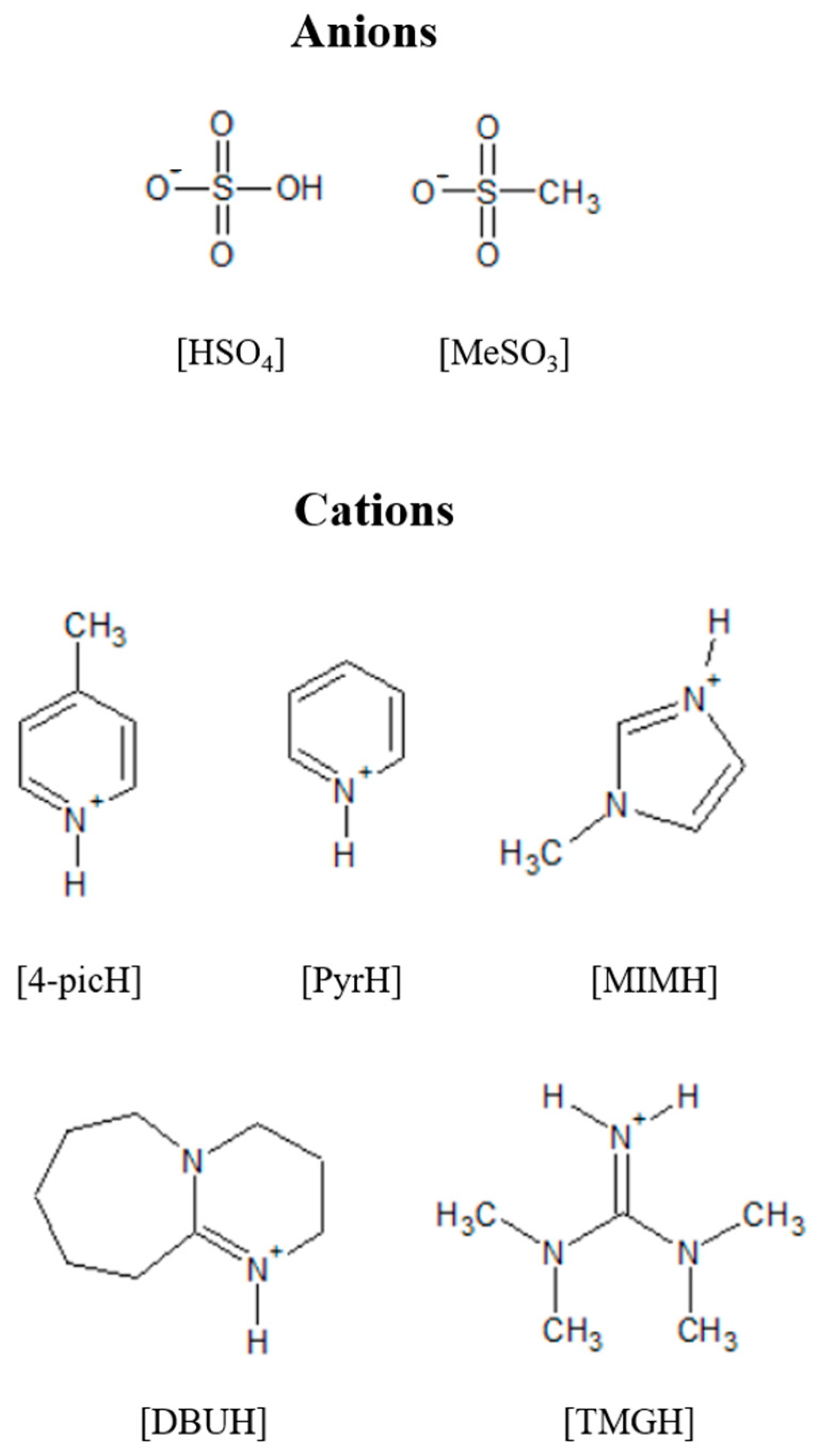
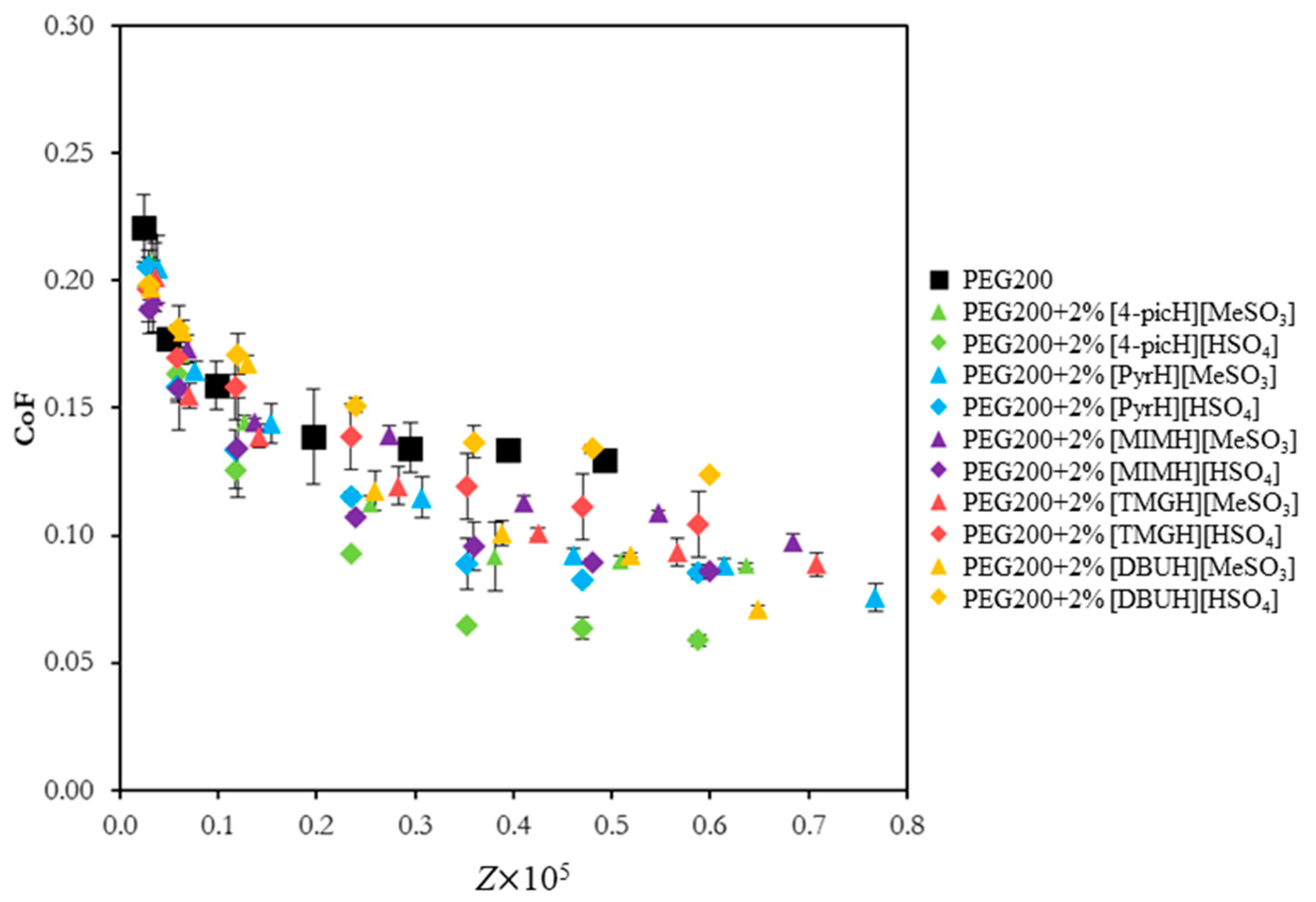
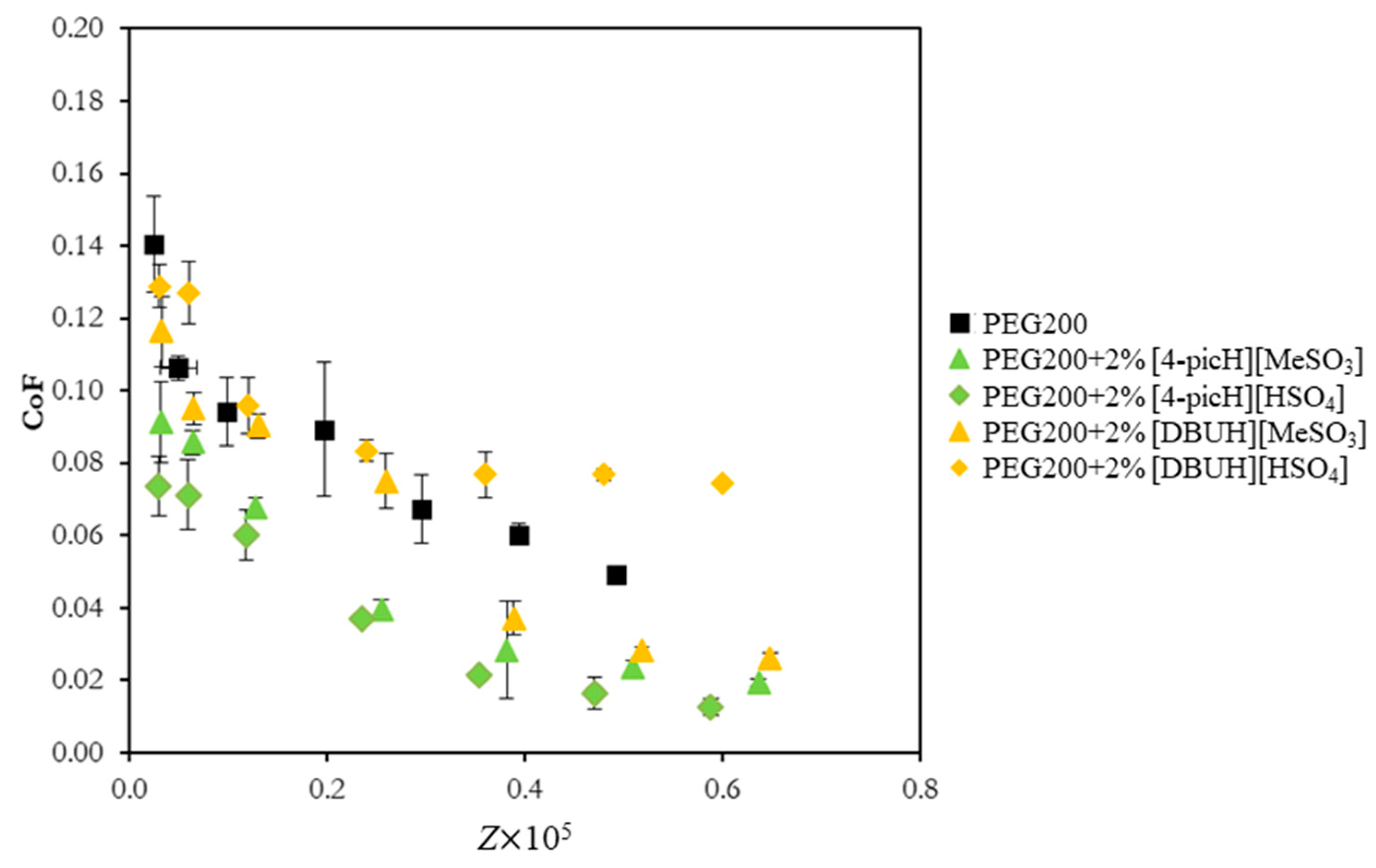


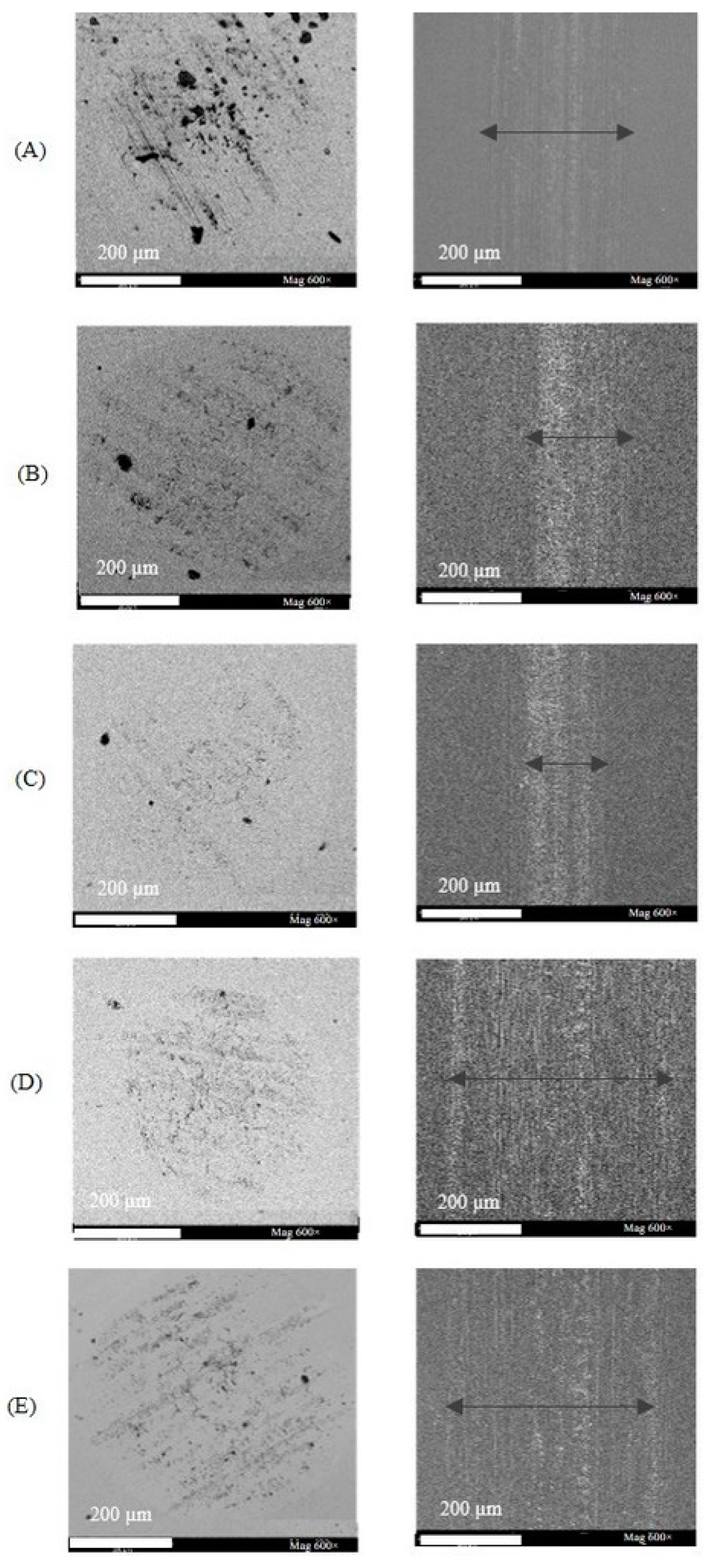
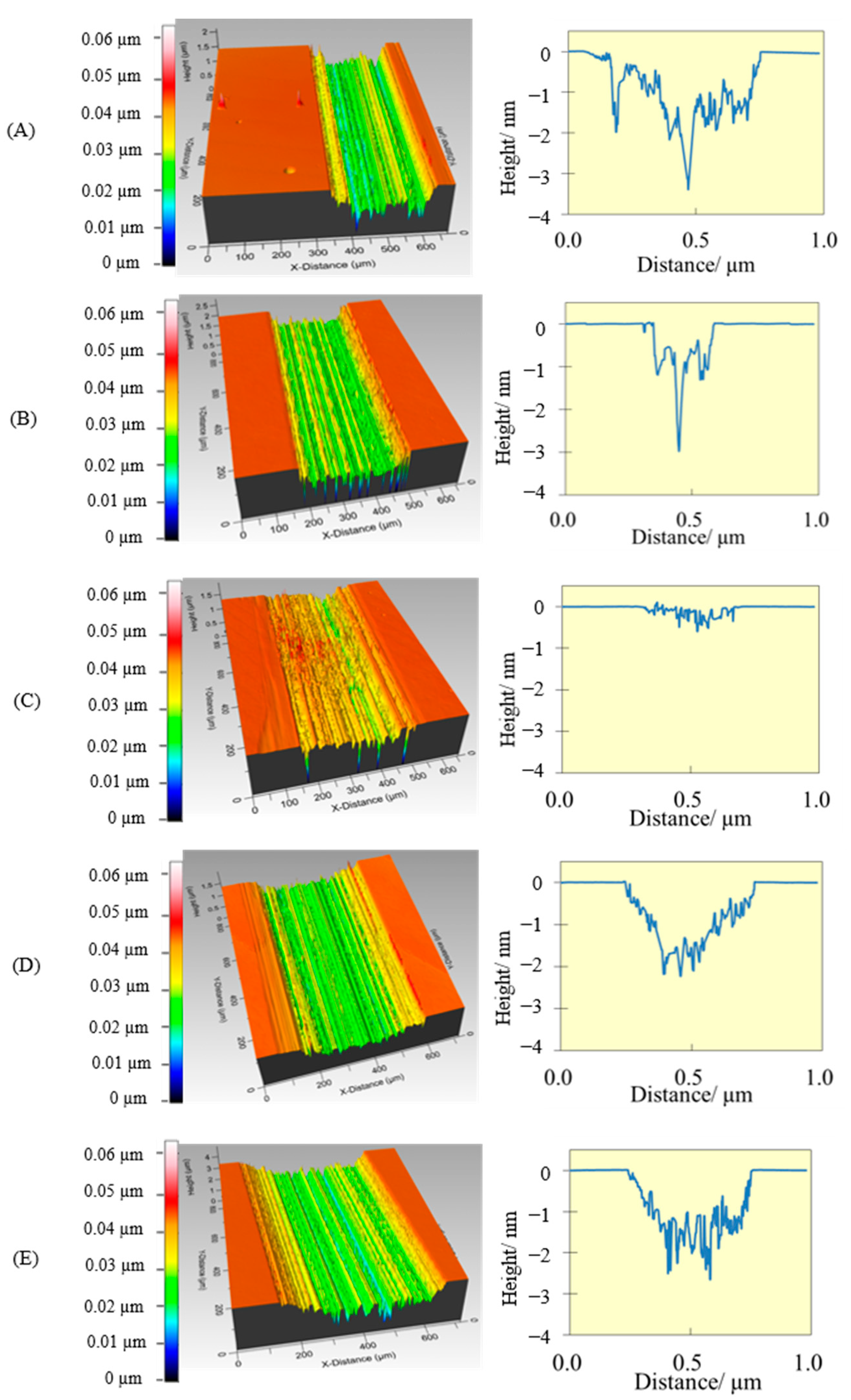
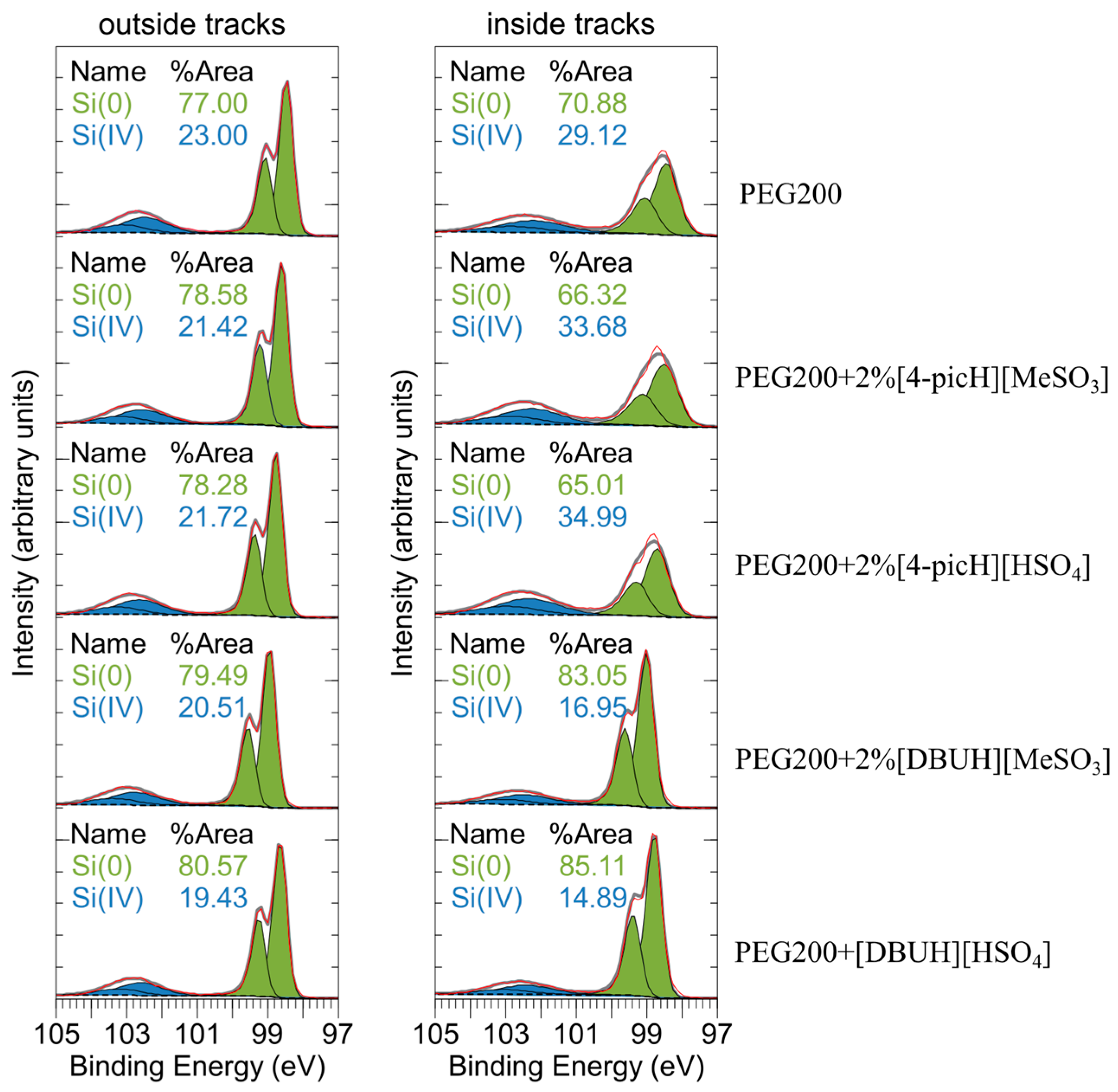
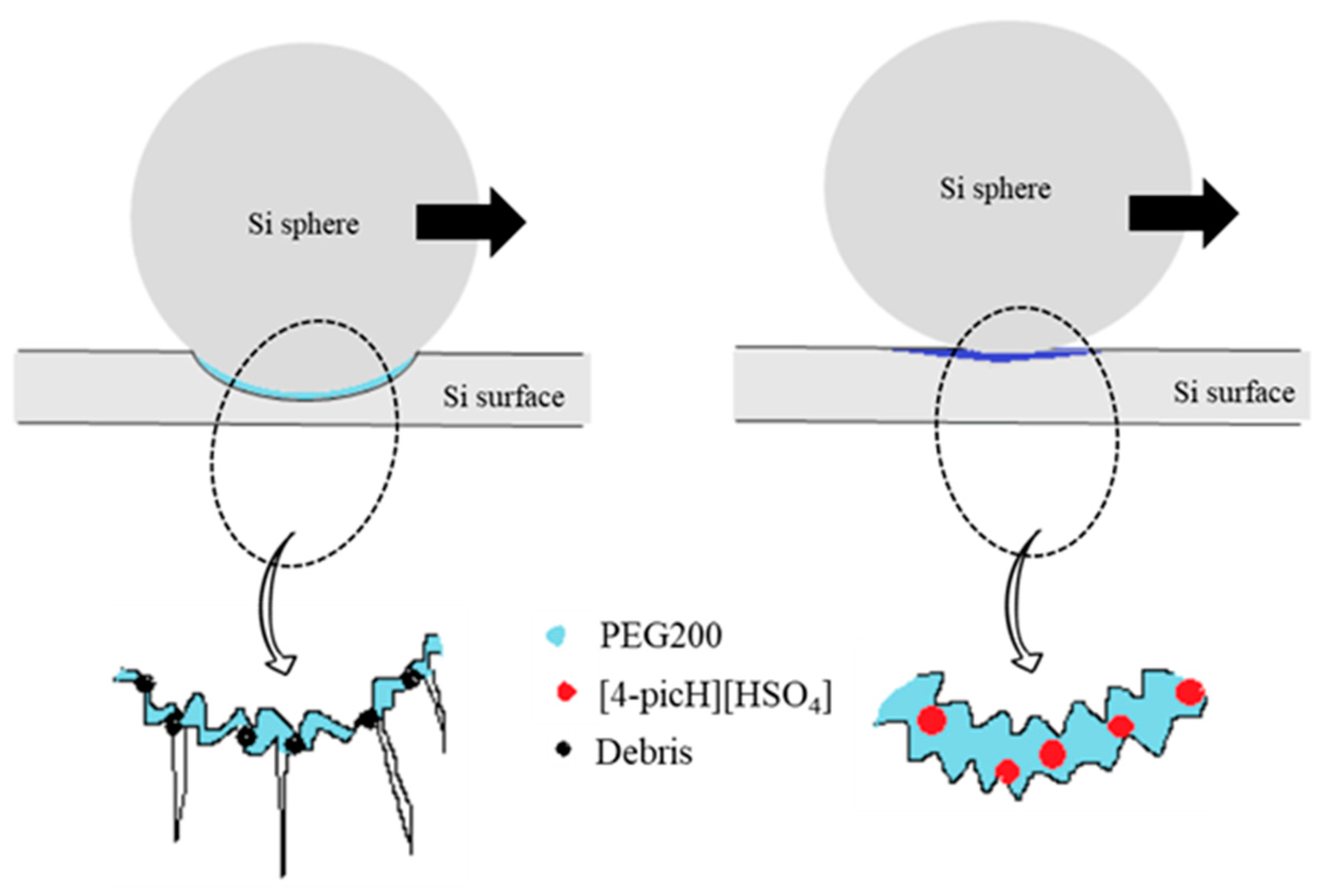
| Liquids | Water Content/ppm | /mPa∙s | Contact Angle/° |
|---|---|---|---|
| PEG200 | 175 | 41 ± 1 | 28 ± 2 |
| PEG 200 + 2% [MIMH][HSO4] | 75 | 50 ± 1 | 26 ± 3 |
| PEG 200 + 2% [MIMH][MeSO3] | 62 | 56 ± 1 | 28 ± 2 |
| PEG 200 + 2% [4-picH][HSO4] | 88 | 49 ± 1 | 27 ± 4 |
| PEG 200 + 2% [4-picH][MeSO3] | 375 | 53 ± 1 | 28 ± 4 |
| PEG 200 + 2% [PyrH][HSO4] | 62 | 48 ± 1 | 26 ± 4 |
| PEG 200 + 2% [PyrH][MeSO3] | 486 | 63 ± 1 | 28 ± 4 |
| PEG 200 + 2% [DBUH][HSO4] | 138 | 50 ± 1 | 22 ± 2 |
| PEG 200 + 2% [DBUH][MeSO3] | 75 | 54 ± 1 | 28 ± 4 |
| PEG 200 + 2% [TMGH][HSO4] | 112 | 49 ± 1 | 18 ± 2 |
| PEG 200 + 2% [TMGH][MeSO3] | 2875 | 58.7 ± 0.5 | 27 ± 4 |
| Lubricant | Relative Atomic Percentages | |||||||
|---|---|---|---|---|---|---|---|---|
| Si 2p | O 1s | C 1s | N 1s | |||||
| In | Out | In | Out | In | Out | In | Out | |
| PEG200 | 37.4 | 45.4 | 31.8 | 35.9 | 30.8 | 18.7 | - | - |
| PEG200 + 2% [4-picH][MeSO3] | 36.4 | 48.3 | 32.2 | 33.3 | 31.4 | 18.4 | - | - |
| PEG200 + 2% [4-picH][HSO4] | 37.8 | 41.6 | 34.1 | 33.3 | 27.7 | 24.6 | 0.4 | 0.5 |
| PEG200 + 2% [DBUH][MeSO3] | 49.2 | 52.1 | 27.7 | 34.9 | 23.1 | 13.0 | - | - |
| PEG200 + 2% [DBUH][HSO4] | 48.7 | 45.5 | 28.2 | 21.1 | 23.1 | 33.4 | - | - |
Disclaimer/Publisher’s Note: The statements, opinions and data contained in all publications are solely those of the individual author(s) and contributor(s) and not of MDPI and/or the editor(s). MDPI and/or the editor(s) disclaim responsibility for any injury to people or property resulting from any ideas, methods, instructions or products referred to in the content. |
© 2023 by the authors. Licensee MDPI, Basel, Switzerland. This article is an open access article distributed under the terms and conditions of the Creative Commons Attribution (CC BY) license (https://creativecommons.org/licenses/by/4.0/).
Share and Cite
Donato, M.T.; Deuermeier, J.; Colaço, R.; Branco, L.C.; Saramago, B. New Protic Ionic Liquids as Potential Additives to Lubricate Si-Based MEMS/NEMS. Molecules 2023, 28, 2678. https://doi.org/10.3390/molecules28062678
Donato MT, Deuermeier J, Colaço R, Branco LC, Saramago B. New Protic Ionic Liquids as Potential Additives to Lubricate Si-Based MEMS/NEMS. Molecules. 2023; 28(6):2678. https://doi.org/10.3390/molecules28062678
Chicago/Turabian StyleDonato, Mariana T., Jonas Deuermeier, Rogério Colaço, Luis C. Branco, and Benilde Saramago. 2023. "New Protic Ionic Liquids as Potential Additives to Lubricate Si-Based MEMS/NEMS" Molecules 28, no. 6: 2678. https://doi.org/10.3390/molecules28062678
APA StyleDonato, M. T., Deuermeier, J., Colaço, R., Branco, L. C., & Saramago, B. (2023). New Protic Ionic Liquids as Potential Additives to Lubricate Si-Based MEMS/NEMS. Molecules, 28(6), 2678. https://doi.org/10.3390/molecules28062678









